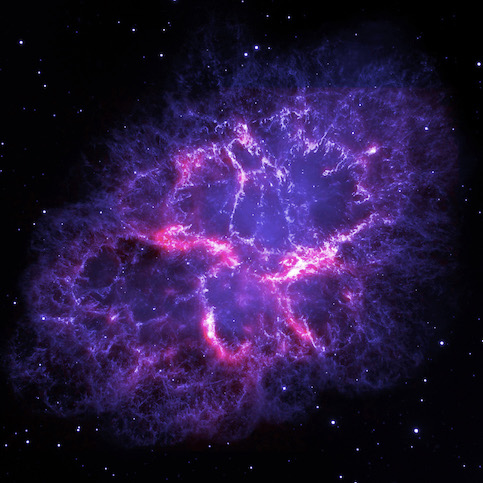Supernova Dust Factories

Stars more than eight times heavier than the Sun are known to enrich galaxies with heavy elements. Near the end of their relatively short lives they eject material in intense winds, sometimes with speeds up to 4 million mph. The enigmatic star eta Carinae is thought to have lost over 80 times the mass of our Sun in the last 1,000 years in the form of gas and dust. Supernovae and their remnants may also be important at polluting galaxies with lots of dust and could be an important place for forming molecules but this is still a controversial topic.
As part of a guaranteed time programme with Herschel, we searched for the tell-tale light shone by dust grains in the historical galactic supernova remnants: Cas A (Figure 1), Tycho (Figure 2), Kepler and the Crab Nebula (Figure 3). This led to the discovery of a new cool dust component in the core-collapse SNe Cassiopeia A (about 30,000 Earth’s worth of dust) led by Mike Barlow (Barlow et al 2010).
We investigated dust in the Crab Nebula which lies about six and a half thousand light years away from Earth and is the remnant of a supernova originally seen by Chinese Astronomers in 1054 AD. Starting out at 12-15 times more massive than the Sun, all that was left after the dramatic death of the star is a tiny, rapidly rotating neutron star and a complex network of ejected stellar material. The Crab Nebula is well known for its intricate nature, with beautiful filamentary structures seen at visible wavelengths. Now, for the first time, astronomers can see exquisite filaments of dust shining in the far-infrared region of the electromagnetic spectrum.
After ruling out other sources of light in the infrared spectrum, we used Herschel to see great detail in the the far-infrared, and found filaments are made of cosmic dust. This provides definitive evidence that the Crab Nebula is an efficient “dust factory”, containing enough dust to make around 30,000-40,000 planet Earths. Unlike in Cas A, the dust may be made of mostly carbon materials, crucial for the formation of planetary systems like our own Solar System.
In many supernova remnants, most of any dust freshly-formed is destroyed as it ploughs into the surrounding gas and dust, crushed by the violent shock waves. A final treat is that the Crab Nebula is a much kinder environment for dust grains, so the dust does not seem to be destroyed (see also Gall et al 2014, Gomez et al 2014). This may be the first observed case of dust being freshly “baked” in a supernova and surviving its outward journey carried along by the shock wave.
{{
A three colour image of the core-collapse remnant Cassiopeia A combined from Herschel PACS images at wavelengths of 70 (blue), 100 (green) and 250 microns (red). See how clear the remnant is in blue, this is due to the infrared emission from hot dust (around 100K) but only a tiny amount of dust is required to shine this brightly at this wavelength. The faint green blob in the centre of the remnant is the newly discovered cool dust component (around 30,000 Earth masses). The red structures all over the map show emission from dust in unrelated Galactic clouds in the foreground (some of this originates from unrelated spiral arm in between us and Cas A). Credit: ESA/HERSCHEL/MESS team.
{{
We also published the first comprehensive study of dust formation in the ejecta of Type Ia supernova remnants (Gomez et al 2012a). A Type Ia supernova originates from the thermonuclear explosion of a low mass star (a white dwarf star) in a binary system with another star. These are the very objects used to probe huge distances as they act like a beacon in the distant Universe – they are extremely bright (so we see them far away) but they are also useful as all Ia explosions are thought to have the same intrinsic energy when they explode. For this reason, Ia explosions were used in a recent study in 1998 which found that that further away supernovae were dimmer than they should be, hence the idea of a mysterious force pushing everything further away from each other than we expected – i.e. dark energy. This study won the Nobel Prize for Physics in 2011 so these astrophysical objects are very important to understand, and the presence of dust around these objects could affect these results.
We found no evidence for significant dust formation in Type Ia supernovae (Figure 2) which places stringent constraints on the environments in which dust and molecules can form, and also in the contribution of these exploding binary systems to the dust budget in galaxies. This is a relief to studies which hope that distant Ia sources are not being “dimmed” by their own dust shells.
See this supernova dust review.